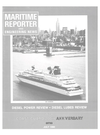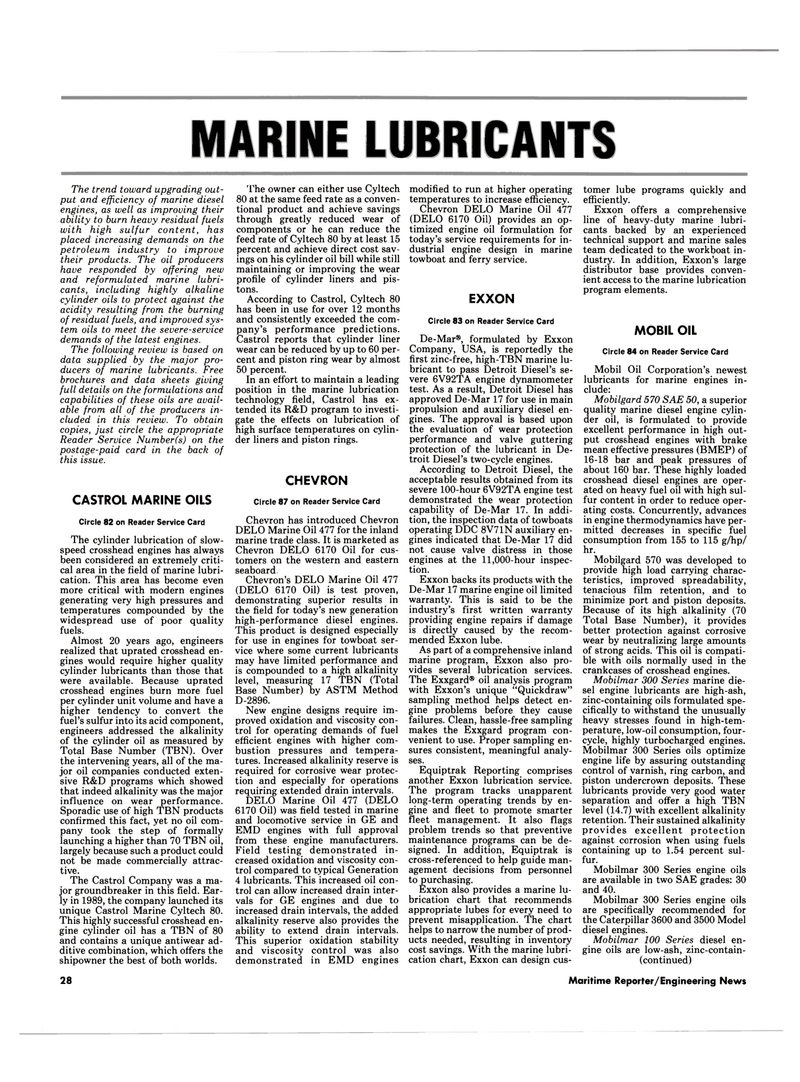
Page 31: of Maritime Reporter Magazine (July 1990)
Read this page in Pdf, Flash or Html5 edition of July 1990 Maritime Reporter Magazine
MARINE LUBRICANTS
The trend toward upgrading out- put and efficiency of marine diesel engines, as well as improving their ability to burn heavy residual fuels with high sulfur content, has placed increasing demands on the petroleum industry to improve their products. The oil producers have responded by offering new and reformulated marine lubri- cants, including highly alkaline cylinder oils to protect against the acidity resulting from the burning of residual fuels, and improved sys- tem oils to meet the severe-service demands of the latest engines.
The following review is based on data supplied by the major pro- ducers of marine lubricants. Free brochures and data sheets giving full details on the formulations and capabilities of these oils are avail- able from all of the producers in- cluded in this review. To obtain copies, just circle the appropriate
Reader Service Number(s) on the postage-paid card in the back of this issue.
CASTROL MARINE OILS
Circle 82 on Reader Service Card
The cylinder lubrication of slow- speed crosshead engines has always been considered an extremely criti- cal area in the field of marine lubri- cation. This area has become even more critical with modern engines generating very high pressures and temperatures compounded by the widespread use of poor quality fuels.
Almost 20 years ago, engineers realized that uprated crosshead en- gines would require higher quality cylinder lubricants than those that were available. Because uprated crosshead engines burn more fuel per cylinder unit volume and have a higher tendency to convert the fuel's sulfur into its acid component, engineers addressed the alkalinity of the cylinder oil as measured by
Total Base Number (TBN). Over the intervening years, all of the ma- jor oil companies conducted exten- sive R&D programs which showed that indeed alkalinity was the major influence on wear performance.
Sporadic use of high TBN products confirmed this fact, yet no oil com- pany took the step of formally launching a higher than 70 TBN oil, largely because such a product could not be made commercially attrac- tive.
The Castrol Company was a ma- jor groundbreaker in this field. Ear- ly in 1989, the company launched its unique Castrol Marine Cyltech 80.
This highly successful crosshead en- gine cylinder oil has a TBN of 80 and contains a unique antiwear ad- ditive combination, which offers the shipowner the best of both worlds.
The owner can either use Cyltech 80 at the same feed rate as a conven- tional product and achieve savings through greatly reduced wear of components or he can reduce the feed rate of Cyltech 80 by at least 15 percent and achieve direct cost sav- ings on his cylinder oil bill while still maintaining or improving the wear profile of cylinder liners and pis- tons.
According to Castrol, Cyltech 80 has been in use for over 12 months and consistently exceeded the com- pany's performance predictions.
Castrol reports that cylinder liner wear can be reduced by up to 60 per- cent and piston ring wear by almost 50 percent.
In an effort to maintain a leading position in the marine lubrication technology field, Castrol has ex- tended its R&D program to investi- gate the effects on lubrication of high surface temperatures on cylin- der liners and piston rings.
CHEVRON
Circle 87 on Reader Service Card
Chevron has introduced Chevron
DELO Marine Oil 477 for the inland marine trade class. It is marketed as
Chevron DELO 6170 Oil for cus- tomers on the western and eastern s63bosrd
Chevron's DELO Marine Oil 477 (DELO 6170 Oil) is test proven, demonstrating superior results in the field for today's new generation high-performance diesel engines.
This product is designed especially for use in engines for towboat ser- vice where some current lubricants may have limited performance and is compounded to a high alkalinity level, measuring 17 TBN (Total
Base Number) by ASTM Method
D-2896.
New engine designs require im- proved oxidation and viscosity con- trol for operating demands of fuel efficient engines with higher com- bustion pressures and tempera- tures. Increased alkalinity reserve is required for corrosive wear protec- tion and especially for operations requiring extended drain intervals.
DELO Marine Oil 477 (DELO 6170 Oil) was field tested in marine and locomotive service in GE and
EMD engines with full approval from these engine manufacturers.
Field testing demonstrated in- creased oxidation and viscosity con- trol compared to typical Generation 4 lubricants. This increased oil con- trol can allow increased drain inter- vals for GE engines and due to increased drain intervals, the added alkalinity reserve also provides the ability to extend drain intervals.
This superior oxidation stability and viscosity control was also demonstrated in EMD engines modified to run at higher operating temperatures to increase efficiency.
Chevron DELO Marine Oil 477 (DELO 6170 Oil) provides an op- timized engine oil formulation for today's service requirements for in- dustrial engine design in marine towboat and ferry service.
EXXON
Circle 83 on Reader Service Card
De-Mar®, formulated by Exxon
Company, USA, is reportedly the first zinc-free, high-TBN marine lu- bricant to pass Detroit Diesel's se- vere 6V92TA engine dynamometer test. As a result, Detroit Diesel has approved De-Mar 17 for use in main propulsion and auxiliary diesel en- gines. The approval is based upon the evaluation of wear protection performance and valve guttering protection of the lubricant in De- troit Diesel's two-cycle engines.
According to Detroit Diesel, the acceptable results obtained from its severe 100-hour 6V92TA engine test demonstrated the wear protection capability of De-Mar 17. In addi- tion, the inspection data of towboats operating DDC 8V71N auxiliary en- gines indicated that De-Mar 17 did not cause valve distress in those engines at the 11,000-hour inspec- tion.
Exxon backs its products with the
De-Mar 17 marine engine oil limited warranty. This is said to be the industry's first written warranty providing engine repairs if damage is directly caused by the recom- mended Exxon lube.
As part of a comprehensive inland marine program, Exxon also pro- vides several lubrication services.
The Exxgard® oil analysis program with Exxon's unique "Quickdraw" sampling method helps detect en- gine problems before they cause failures. Clean, hassle-free sampling makes the Exxgard program con- venient to use. Proper sampling en- sures consistent, meaningful analy- ses.
Equiptrak Reporting comprises another Exxon lubrication service.
The program tracks unapparent long-term operating trends by en- gine and fleet to promote smarter fleet management. It also flags problem trends so that preventive maintenance programs can be de- signed. In addition, Equiptrak is cross-referenced to help guide man- agement decisions from personnel to purchasing.
Exxon also provides a marine lu- brication chart that recommends appropriate lubes for every need to prevent misapplication. The chart helps to narrow the number of prod- ucts needed, resulting in inventory cost savings. With the marine lubri- cation chart, Exxon can design cus- tomer lube programs quickly and efficiently.
Exxon offers a comprehensive line of heavy-duty marine lubri- cants backed by an experienced technical support and marine sales team dedicated to the workboat in- dustry. In addition, Exxon's large distributor base provides conven- ient access to the marine lubrication program elements.
MOBIL OIL
Circle 84 on Reader Service Card
Mobil Oil Corporation's newest lubricants for marine engines in- clude:
Mobilgard 570 SAE 50, a superior quality marine diesel engine cylin- der oil, is formulated to provide excellent performance in high out- put crosshead engines with brake mean effective pressures (BMEP) of 16-18 bar and peak pressures of about 160 bar. These highly loaded crosshead diesel engines are oper- ated on heavy fuel oil with high sul- fur content in order to reduce oper- ating costs. Concurrently, advances in engine thermodynamics have per- mitted decreases in specific fuel consumption from 155 to 115 g/hp/ hr.
Mobilgard 570 was developed to provide high load carrying charac- teristics, improved spreadability, tenacious film retention, and to minimize port and piston deposits.
Because of its high alkalinity (70
Total Base Number), it provides better protection against corrosive wear by neutralizing large amounts of strong acids. This oil is compati- ble with oils normally used in the crankcases of crosshead engines.
Mobilmar 300 Series marine die- sel engine lubricants are high-ash, zinc-containing oils formulated spe- cifically to withstand the unusually heavy stresses found in high-tem- perature, low-oil consumption, four- cycle, highly turbocharged engines.
Mobilmar 300 Series oils optimize engine life by assuring outstanding control of varnish, ring carbon, and piston undercrown deposits. These lubricants provide very good water separation and offer a high TBN level (14.7) with excellent alkalinity retention. Their sustained alkalinity provides excellent protection against corrosion when using fuels containing up to 1.54 percent sul- fur.
Mobilmar 300 Series engine oils are available in two SAE grades: 30 and 40.
Mobilmar 300 Series engine oils are specifically recommended for the Caterpillar 3600 and 3500 Model diesel engines.
Mobilmar 100 Series diesel en- gine oils are low-ash, zinc-contain- (continued) 28 Maritime Reporter/Engineering News

 30
30

 32
32
